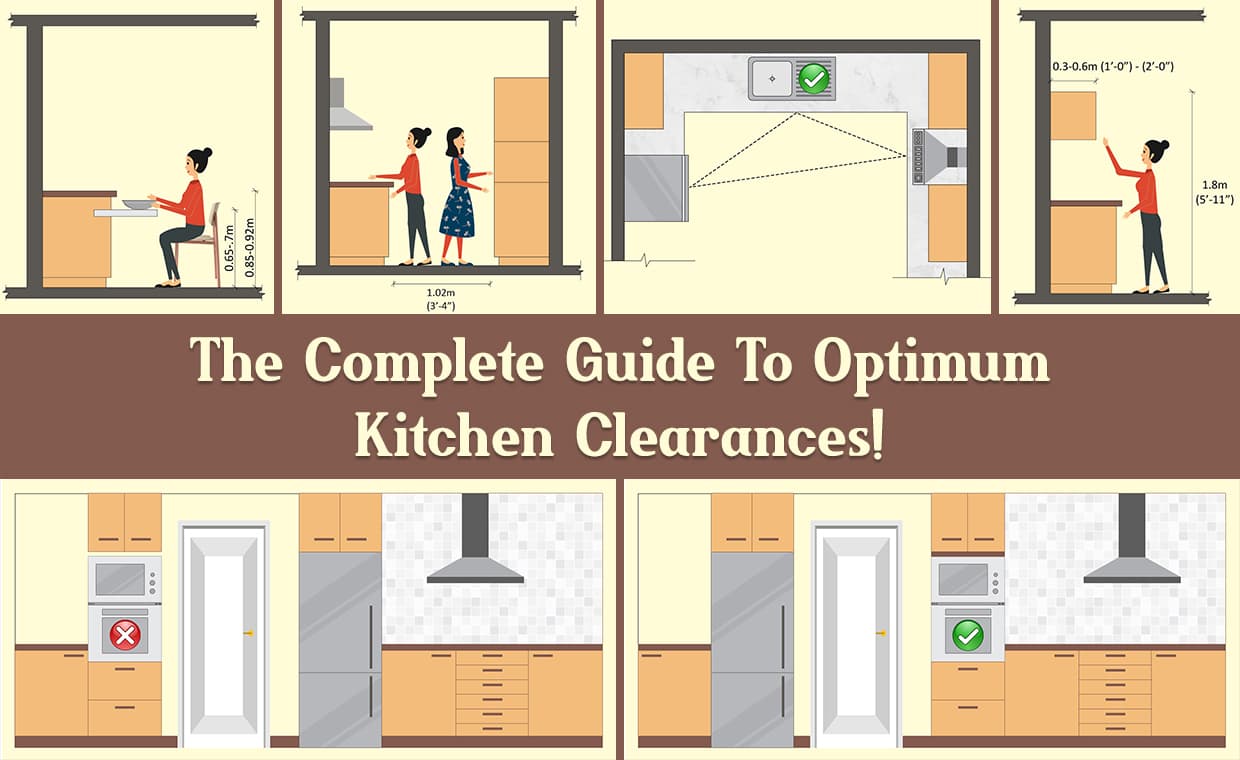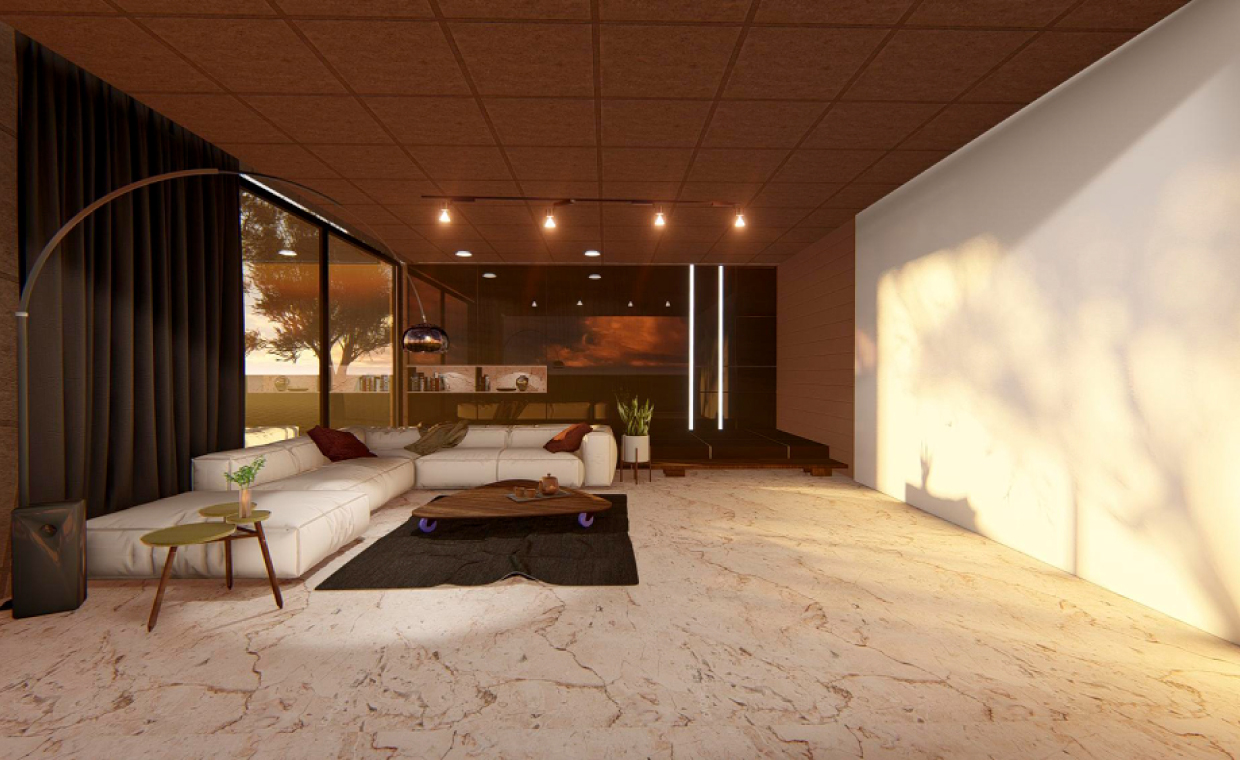
As quoted by Louis Parrish “If you can organize your kitchen, you can organize your life.” In order to work out your kitchen spaces well, have adequate space for kitchen work surfaces and optimum kitchen clearances. If you get this privilege of designing your kitchen from its start, then what else do you want? You could then size everything in kitchen as you like and according to your anthropometry. It would be better to consider the standards that suits best to you…
Main Kitchen Work Surfaces in Kitchen Design
Kitchen work surfaces and centers should have the adequate storage space, adequate counter space, necessary utilities like water (hot /cold) and adequate lighting. Here are some of the best tips which would guide you work out your spaces in kitchen with optimum kitchen clearances and help you to answer how to organize kitchen. Let’s start with the main kitchen work surfaces or centers of activity to be initially thought in kitchen design:
01. Cleaning Area in Kitchen:
It is a work area in kitchen where the cleaning of utensils takes place. The various utensils used during cooking process are being cleaned either in sink and/or dishwasher. This kitchen work zone is as important as cooking and preparation area!

The cleaning area must provide extra storage for things like soap, dish washing detergents, sponges, cloths and towels. If your kitchen has dishwasher, then the sink must be located within 36’’ of your dishwasher. Additionally, your cleaning area must have countertop space to allow the clean dishes to dry as well as to collect dirty dishes.
02. Preparation Area in Kitchen:
After providing hob (gas stove) you should have some space on counter/platform for preparation. Preparation area is typically used for mixingor the initial preparation either on kitchen counter / platform or island.

The major activities happening here are washing, chopping and mixing ingredients. The preparation area must hence have lots of countertop space for working. It must be in proximity to refrigerator and sink for washing veggies. It must also have storage for keeping chopping boards, knives and mixing bowls. Additionally, the ingredient must be within the reach of the preparation area.
03. Cooking Area in Kitchen:
It is the important work area in kitchen, where the food is cooked! Hob (Gas Stove) is generally located on the kitchen counter / platform or island depending on individual use. This area also includes chimney above the stove to suck the odours from kitchen. To get rid of kitchen odours, you may also have a look at this blog:

Always keep in mind that your cooking center must be centered on the kitchen’s cooktop. It must offer easy access to oven. Additionally, the ingredients and seasonings like salt and pepper must be within the reach of the cooking area.
04. Serving Area in Kitchen:
It is the work area in kitchen where the cooked food is served to consume! In other words, it is the spot that’s out of cook’s way, where you can set out buffet style meal or we can say as an area, where prepared food is ready to serve before meals.

The serving area must be at such a place from where the utensils such as dishes, fork, spoons and glasses are easily accessible and ready to serve in it. It must be also near to refrigerator so that you can easily access it for getting cold drinks or water bottles.
Most of the kitchen layouts must start from the concept of kitchen work triangle. To know how kitchen work triangle works and what it is in detail, here’s a blog for you:
Optimum Kitchen Clearances
All Kitchen work surfaces are equally important for the efficient kitchen design in the house. We have All Kitchen work surfaces are equally important for the efficient kitchen design in the house. We have brought up a kitchen planning guide for you. The minimum kitchen clearances required for a person are as follows:
01. The entry door should not interfere with the appliance doors. Hence, if the width of your door is 0.8meter (2’-7″), then, a minimum clearance of the pull side for the door must be door width plus 0.45meter (1’-6″) x 1.5meter (4’- 11”) and for the push side of the door, it must be the width of the door x 1.20 meter (3’- 11”).


02. The minimum clearance of work zone is 1.02 meter (3’-4’’). It must be provided to accommodate the human body and various movements related to cooking.

03. 1.2 meter (3’- 11”) – 1.5meter (4’- 11”) is the minimum clearance distance between kitchen appliances that will allow comfortable circulation between multiple work surfaces and appliances. It will allow multiple works to happen in kitchen at a same time.

04. According to Joseph De Chiara, et.al. (Published in Time Saver Standards for Interior Design and Space Planning) the width of the kitchen countertop must be 0.7 meter (2’-3″) and height for the platform must be 0.92 meter (3’-0″).

05. The minimum clearance distance between the two opposite counters in kitchen should be 1.20 meter (3’- 11”). It is needed if two or more people are working in the kitchen at the same time. This distance is kitchen island spacing requirements which is required for one person to turn and pass by while the other is standing on the other side facing opposite kitchen counter.

06. The minimum floor space distance between the kitchen countertop and kitchen island is 1.00 meter (3’- 3″). It is the minimum distance between kitchen island and counter.

07. The kitchen island clearances are as follows: For easy movement for two people in the kitchen, 1.5 meter (4’- 11″) is required between the two countertops.

08. 1.00 meter (3’- 3″) is the distance in front of a cooking range (with oven). It will allow bending and allow keeping inside comfortably.

09. 0.90 meter (2’- 11″) is the minimum clearance in front of a refrigerator to enable one to bend, open the refrigerator and take out the stuff from it.

10. 0.9 meter (2’- 11″) is the minimum clearance in front of the base cabinets, below the counter to allow one to bend and reach for something. Here, the depth of the base cabinets is 0.6 meter (1’- 11″) and extra space to approach the things from the cabinets.

11. 0.9 meter (2’- 11″) is the minimum clearance in front of the drawer to enable one to pull out the drawer.0.6 meter(1’- 11″)remains the depth and extra space to approach the things from the drawer.

12. Rotating Corner Base Cabinet: If you have L-shaped kitchen and you are planning to have a rotating corner base cabinet to make the full use of corners, then, 0.9meter (2’- 11″) of wall space is required from both the corner walls.

13. 1.00 meter (3’- 3″) is the minimum clearance in front of a dishwasher section. Here, the height of the door of the dishwasher is 0.8 meter (2’- 7″)and extra space to bend and pull out the drawers from inside.

14. A full height tall obstacle should not disturb the two work centers as shown in the figure. It will divide the cleaning and cooking work centres. Instead, it can be kept on the left most side so that it both the work centres are not disturbed.


15. According to Joseph De Chiara, et.al. (Published in Time Saver Standards for Interior Design and Space Planning) the maximum height of the wall shelves (kitchen cabinets clearance) i.e. uppers cabinets should be 1.8meters (5’- 10″). The depth of the wall shelves varies according to its usage from 0.3meter (1’-0’’) to 0.6meter (2’-0’’).

16. According to Neufert standards, the total length of the travel distances between the three work centers i.e. stove, sink and refrigerator should be between 5.5 meters (18’- 0″) to 6 meters (19’- 8″). Here, the distance is measured from the center of each appliance. It is known as kitchen work triangle.
17. The distance between the sink and stove must not exceed 1.8meters (5’- 10″).
18. The sink must be placed in the center of the kitchen work triangle because it is the most used area of the kitchen, be it used for cleaning vegetables or cleaning utensils.

19. Your foot traffic must not cross through the basic work triangle. Hence, your kitchen must not become the main passage towards the rest of the home. In this image below, you can see that Built-in-oven lies on another corner of the kitchen from where the foot traffic crosses the kitchen triangle. Hence, it must be placed in such a way that it includes within the kitchen work triangle so that it does not cross through the passage.


20. 0.9 meter (2’- 11″) is the width of a walkway in the kitchen. A walkway is the passage throughout the kitchen.

21. There is a difference between walkway aisle and work aisle. The work aisle is an area where a person stands while working in the kitchen. The width of the work aisle must be 1.06meter (3’- 5″).

22. Dishwasher placement: When you place a dishwasher in the corner, the minimum clearance of 0.5 meter (1’- 7″) from the corner must be provided. You must allow some standing space in front of dishwasher for unloading the utensils.

23. Sink Placement: The sink should be placed in such a way that it must include 0.6 meter (1’- 11″) of landing area on one of the side of the sink and 0.45 meter (1’-5’’) of the landing area on the other side.

24. A minimum clearance of 0.3 meter (0’-11’’) must be kept form the edge of the sink to the inside corner of countertop.

25. There must be a minimum clearance height of 0.55meter (1’-9’’) above the sink. Generally, the wall behind the sink holds a window as seen in the previous point, but if the wall space is minimum, there are wall cabinets above the sink as well.

26. Food Preparation – Work Area: You must include a minimum of 0.76 meter (2’-6’’) of distance for your primary food preparation area.

27. Pullout Worktop: According to Neufert standards, if there is a pullout worktop in your kitchen, then the standard height for the worktop must be 0.85meter (2’-9’’) so that when a person can comfortably work while sitting on a chair.

28. Serving Area: You must include a serving area with a minimum width of 0.9meter (2’-11’’).
29. Cooking Surface Landing Area: A minimum clearance of 0.38 meter (1’-3’’) and 0.31 meter (1’-0’’) of the landing area must be included on either side of the cooking area.

30. Cooking Surface Clearance: there must be minimum clearance of 0.6 meter (1’-11’’) between the cooking surface and the non-combustible surface above it.

31. Microwave Oven Placement: The microwave must be located by considering the user’s height and abilities. The ideal location for microwave if placed above the countertop should not be more than 1.3 meter (4’-3’’) i.e. 0.1 meters (0’-3’’) below the user’s shoulder.

32. If microwave is placed below the countertop, it must be 0.38 meter (1’-3’’) above the finished floor level. Try to keep microwave oven at the most active part of the kitchen.

33. Traffic Clearance at Seating:

In a seating area, where no traffic passes from behind, a minimum clearance of 0.8meter (2’-7’’) must be provided from the edge of the dining table to the wall or any obstruction behind the seating area.
34. For a person to edge past the person sitting on the dining table, minimum 0.9meter (2’-11’’) distance is required.

35. For a person to walk from behind the person sitting on the dining table, 1.1 meter (3’-7’’) is required.

36. Breakfast Counter Seating Space:

For every person sitting on the breakfast counter, the minimum dimensions for knee space at the table or breakfast counter must be 0.9meter (2’-11’’) width x 0.68meter(2’-3’’) height x 0.48meter (1’-7’’) depth.
37. Breakfast Bar Height: According to Neufert standards, the standard height for the breakfast bar or breakfast counter must in between 1.1 meter (3’-7’’) to 1.15meter (3’-9’’).

38. Consider the items to be stored according to your daily needs so that you can easily access it. Always remember to keep heavy equipment near the floor level. The wall cabinets are economical to provide convenient space for smaller items which are frequently used.
39. Standard height of the Utility Cabinets: The standard height for utility cabinets varies from 2.13meter (7’-0’’) to 2.43meter (8’-0’’).

40. Light in Kitchen: Kitchen activities become tiresome in poor light. Hence windows must be placed in the kitchen for light as well as ventilation. The need for light is greatest over work centers. Thus, you can also install light fixtures beneath the wall cabinets.

41. Natural ventilation in Kitchen is a must which has to be provided from doors and windows. Thus, a minimum of 5% of the total floor area of the kitchen must be provided for ventilation.
42. For the safety purposes, install a fire extinguisher that can be easily accessed in case of any fire in the kitchen.
Conclusion
We hope that our kitchen spacing guidelines would help you in making smart decisions for your kitchen. Make sure that your kitchen requires enough space according to your design layout rather than just selecting beautiful finishes. By reading the afore-mentioned kitchen design guidelines for kitchen work surfaces and optimum kitchen clearances, we assure that you will definitely create an accessible space in your kitchen.
Since you are already reading about kitchen clearances, are your kitchen cabinets at appropriate heights? If not, go through this one:
And before you take a leave from us, you must definitely visit our most read blogs that our readers have loved…!
Also Read:
Optimum Size of Kitchen Furniture With Respect to Human Dimensions!
11 Tips To Avoid Mistakes In Kitchen Design
10 Modular Kitchen Appliances: That’ll Make your Life *way* Easier

































